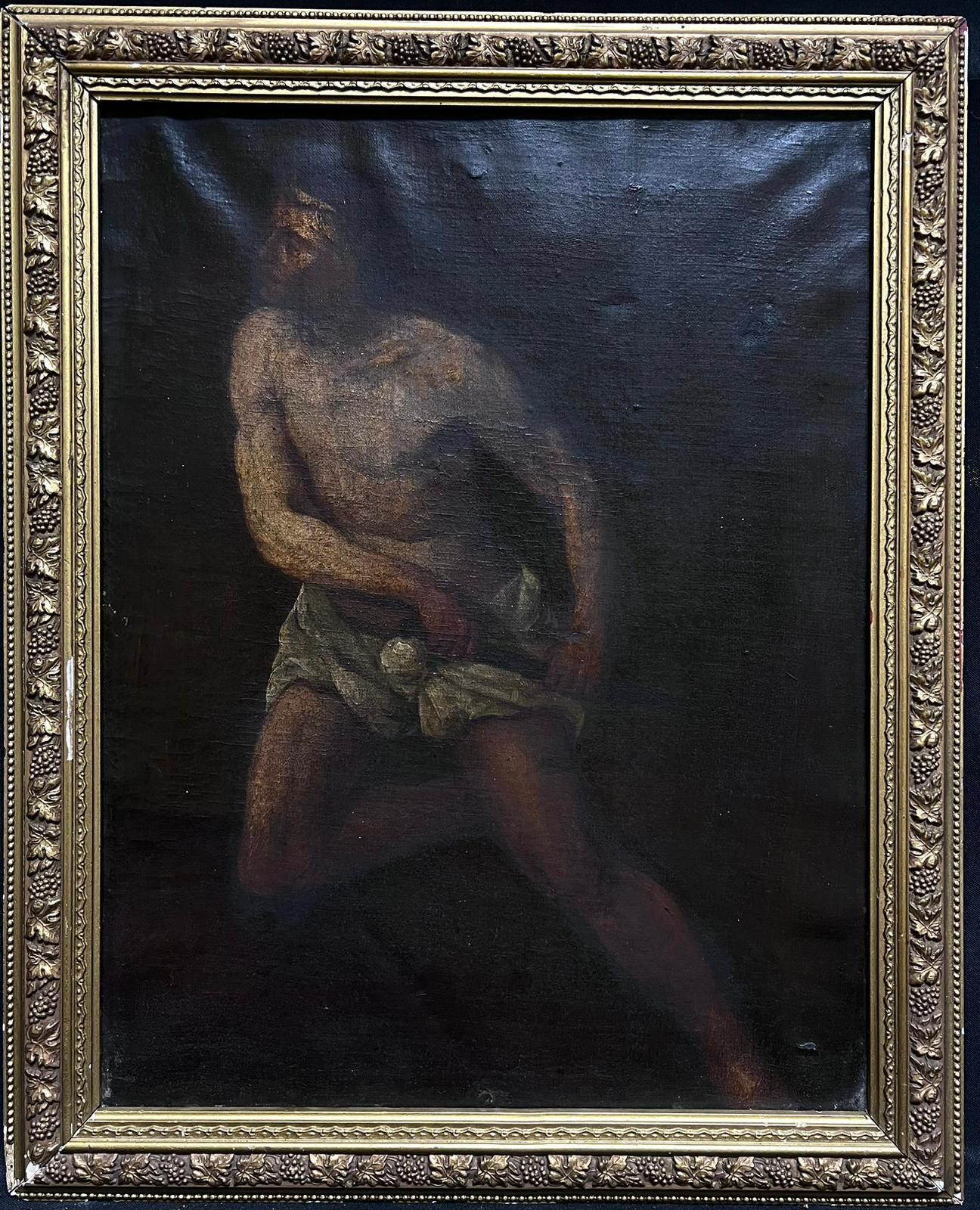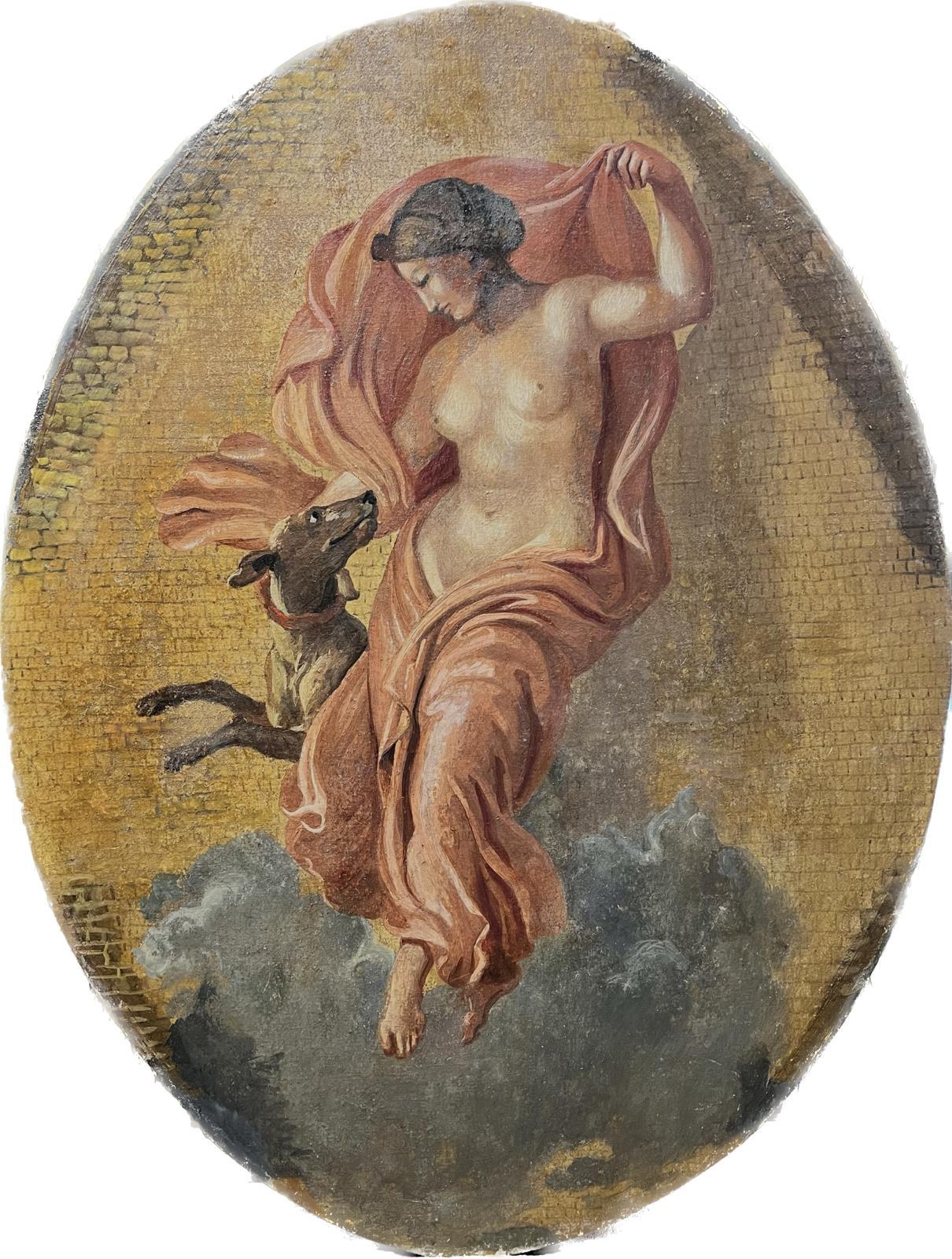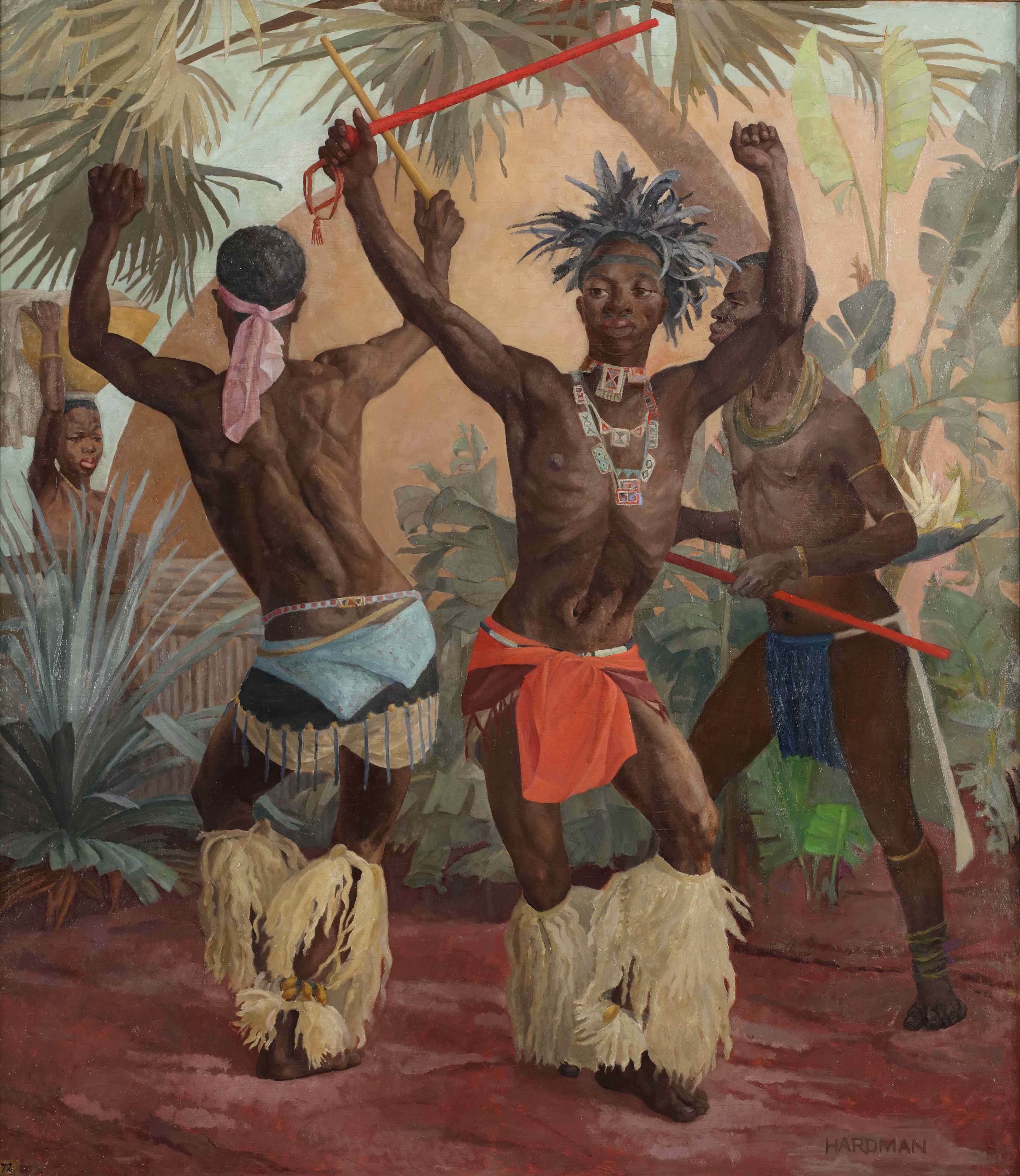Items Similar to Portrait of Putti Playing - French 17th century art Old Master oil painting
Want more images or videos?
Request additional images or videos from the seller
1 of 16
Laurent de La HyrePortrait of Putti Playing - French 17th century art Old Master oil paintingCirca 1645
Circa 1645
About the Item
This stunning French 17th century Old Master oil painting is by Baroque artist Laurent de la Hyre. It was painted circa 1645 and has excellent provenance from Christie's. The painting is a superb large oil on canvas depicting two Putti or winged male cherubs in the foreground, on the edge of a wood. They are wrestling over some reeds, their red and black bows discarded in their play. The putti are beautifully illuminated, almost glowing with a superb play of light and shadow on their bodies against the darker background of the woods and landscape. The detail in their wings, hair and the flora and fauna are fantastic. This is a stunning large French Baroque Old Master oil painting from the 17th century and an excellent example of Hyre's work
Provenance. Christie's, 'Old Master Pictures', 11 December 2002, lot 79. Stamp verso.
Condition. Oil on canvas, 46 inches by 36 inches and in good condition.
Frame. Housed in an ornate gilt frame, 54 inches by 44 inches and in good condition.
Laurent de La Hyre (1606-1656) was a French Baroque painter, born in Paris. He was a leading exponent of the neoclassical style of Parisian Atticism. La Hyre was greatly influenced by the work of Italian artists who came to Paris. He became a pupil of Georges Lallemand and studied the works of Primaticcio at Fontainebleau, but never visited Italy. La Hyre's captivating use of color and delicately posed figures are a trademark of his early, painteresque style. He was an innovative artist who used his superior skills as a storyteller to portray rarely depicted subjects. La Hyre is associated with the transitional period before the introduction of the French Baroque by Simon Vouet. His picture of Pope Nicholas V opening the crypt in which he discovers the corpse of St. Francis of Assisi standing (located at the Louvre) was executed in 1630 for the Capuchin friars of the Marais; its gravity and sobriety seems to have been influential for the next generation of French painters, particularly Eustache Le Sueur. The Louvre contains eight other works, and paintings by La Hyre are in the museums of Strasburg, Rouen and Le Mans. His drawings, of which the British Museum possesses a fine example, Presentation of the Virgin in the Temple, are treated as seriously as his paintings, and sometimes show simplicity and dignity of effect. The example of the Capuchins, for whom he executed several other works in Paris, Rouen and Fécamp, was followed by the goldsmith's company, for whom he produced in 1635 St. Peter healing the Sick (Louvre) and the Conversion of St Paul in 1637. In 1648, La Hyre was one of the founders of the French Royal Academy of Painting and Sculpture and was elected as one of the original twelve elders in charge of its running. Richelieu called La Hyre to the Palais Royal; Pierre Séguier, Gédéon Tallemant des Réaux and many others entrusted him with important works of decoration; for the Gobelins he designed a series of large compositions. La Hyre painted also a great number of portraits, and in 1654 united in one work for the town-hall of Paris those of the principal dignitaries of the municipality. His students included François Chauveau.
A putto is a figure in a work of art depicted as a chubby male child, usually naked and sometimes winged. Originally limited to profane passions in symbolism, the putto came to represent the sacred cherub (plural cherubim), and in Baroque art the putto came to represent the omnipresence of God. A putto representing a cupid is also called an amorino (plural amorini) or amoretto (plural amoretti).
- Creator:Laurent de La Hyre
- Creation Year:Circa 1645
- Dimensions:Height: 44 in (111.76 cm)Width: 54 in (137.16 cm)Depth: 2 in (5.08 cm)
- Medium:
- Movement & Style:
- Period:
- Condition:
- Gallery Location:London, GB
- Reference Number:1stDibs: LU853113076612
About the Seller
5.0
Platinum Seller
These expertly vetted sellers are 1stDibs' most experienced sellers and are rated highest by our customers.
1stDibs seller since 2018
398 sales on 1stDibs
Typical response time: <1 hour
- ShippingRetrieving quote...Ships From: London, United Kingdom
- Return PolicyA return for this item may be initiated within 14 days of delivery.
More From This SellerView All
- Seated Nude Model in Art Class - British 40's Slade School portrait oil paintingBy E.A. JayLocated in London, GBThis superb Post Impressionist Slade School female full length seated nude portrait oil painting is by female artist E A Jay. Painted in the 1940'...Category
1940s Post-Impressionist Nude Paintings
MaterialsOil
- The Night Passeth, the Day Cometh - British Post Impressionist art oil paintingBy Harry MorleyLocated in London, GBThis superb British exhibited Post Impressionist oil painting is by much sought after noted artist Harry Morley. It was painted in 1921 and exhibited that year at the Royal Academy L...Category
1920s Post-Impressionist Portrait Paintings
MaterialsOil
- Portrait of Woman Bathing-Scottish 20's Impressionist nude interior oil paintingBy David FoggieLocated in London, GBA large, original Scottish portrait by noted Scottish artist David Foggie. This oil on canvas depicts a woman bathing and is one of his best portraits. It dates to 1924 and is in fin...Category
20th Century Impressionist Portrait Paintings
MaterialsOil
- Pre-Raphaelite Beauty - Victorian art nude oil portrait - British female artistBy Sara Wells PageLocated in London, GBPainted by Sara Wells Page this is a large stunning half-length Pre-Raphaelite portrait oil painting of a semi clad young woman. It was painted circa 1900 by Page who worked and exhi...Category
Early 1900s Victorian Nude Paintings
MaterialsOil
- Nude Portrait of a Spanish Woman - Scottish art female portrait oil paintingBy William CrosbieLocated in London, GBThis striking nude portrait oil painting is by noted Scottish artist William Crosbie. It is entitled Guapa verso, Spanish for a beautiful woman. Painted in 1981, she is wearing a bla...Category
20th Century Nude Paintings
MaterialsOil
- Seated Female Nude Portrait - British 1930's portrait oil painting Empire frameBy Harold KnightLocated in London, GBThis superb British nude portrait oil painting is attributed to the circle of Harold Knight. Painted circa 1930, it is a seated study of a nude woman in soft focus, arms raised to on...Category
1930s Realist Portrait Paintings
MaterialsAdhesive, Oil
You May Also Like
- Early 17th Century Italian Old Master Semi Nude Man with Dagger oil paintingBy Michelangelo Merisi da CaravaggioLocated in Cirencester, GloucestershireSemi Nude Man drawing a Dagger Italian School, early 17th century circle of Caravaggio oil on canvas, framed framed: 21 x 17 inches canvas : 18 x 14 i...Category
Early 17th Century Old Masters Portrait Paintings
MaterialsCanvas, Oil
- Fine Antique Classical Nude Draped in Robes Dancing with Dog Gold BackgroundLocated in Cirencester, GloucestershireArtist/ School: Italian School, 19th century Title: Classical nude draped in robes with dancing dog. The work looks as though it might have been a ceiling...Category
19th Century Old Masters Nude Paintings
MaterialsCanvas, Oil
- Model undressingLocated in BELEYMAS, FRJulius EXNER (Copenhagen, 1825 - Copenhagen, 1910) Model stripping Oil on canvas H. 122 cm; L. 74 cm Signed and dated 1842 lower right Exhibition: most likely Charlottenborg Salon of 1845, under number 110, titled Modelfigur, awarded with a silver medal Provenance: Emilio Fernando Bolt (c.1860 - 1944), acquired from the artist around 1900, then by descent Our painting was produced as part of the summer sessions organized between 1839 and 1850 by Christoffer Wilhelm Eckersberg (1783-1853), the master of Danish painting of the first half of the 19th century, in his private studio-apartment on the ground floor. floor at the Royal Academy of Fine Arts in Copenhagen. The master brought together a few students there between June and September, rented one or two models for the season, which were painted from different angles, the artists (including Eckersberg himself) sitting side by side. Eckersberg used to paint a fairly small version, the pupils of the larger formats. The work fits more generally into the legendary context of the research and reforms carried out by Eckersberg concerning the studies of nudes and in particular of female nudes, to make this exercise a genre of painting in its own right. Following his two-year stint in Jacques-Louis David's studio in Paris in 1811, Eckersberg had been made aware of work on the nude and in particular on live models, in natural light, while in Denmark the drawings were then only made from casts of antique models or other mannequins. In 1822, when he had been a professor there since 1818, it was he who had the Royal Academy of Copenhagen authorize the study of nudes, no longer in the evening by candlelight, but in natural light; from 1833, it was still he who allowed students to work on nude female models, even if the official authorization of the Academy did not take place until 1839. It was this same year that he instituted his summer sessions, on a private basis, to orient his painting and that of his students towards a new conception of the representation of models: even if the nude remains the real theme, it does not however, this is more than just an academic exercise. The subject is placed in a contemporary interior, with a rather sophisticated decor, and occupied with an intimate activity (it is this type of intimate vein that we will find later in Degas or Cassatt for example); thus in our painting, the young woman is supposed to take off her clothes to wash. The objective is that the viewer forgets that the master and his students are painting a model during a posing session, and that he instead has the impression of being alone with the model, but invisible, almost like a voyeur in spite of himself. Moreover, in these paintings, the model never looks towards the spectator, inducing a psychological distance with him, whereas model and artist are actually physically very close. On the other hand, it is not a question of idealized nudes either, even if Eckersberg, proof of his debt to the antique, chooses fairly classic models and poses. The sensuality is real and very present, with dreamy, even innocent, and timeless expressions (the models do not seem to have a defined age), suave and slow attitudes and movements, and especially with clothes that hide or reveal skillfully parts of the female body: upper buttocks, pronounced hips... Made by an artist under 20, our sensual painting is probably one of the most beautiful and spectacular produced by the students of Eckersberg during these summer sessions. With a perfect balance between the firmness of an ancient statue (it recalls the Venus de Milo) and the softness of the feminine forms, highlighted by a harmonious palette, it captures the attention with many details: the almost photographic folds white clothing...Category
1840s French School Nude Paintings
MaterialsCanvas, Oil
- 'Zulu Dancers'Located in Amsterdam, NL‘Zulu Dancers’ Signed bottom right Hardman, titled on a sticker at the reverse and with address Walton End, Walton Lane, Bosham, Chichester, and Price 45 gns. Oil on board, 99 x 87...Category
20th Century Expressionist Nude Paintings
MaterialsOil, Board
- Nude oil painting, large post-impressionist sitting nude by Pio SantiniLocated in AIGNAN, FRLarge vintage nude portrait oil painting of a woman sitting. This is a gorgeous, colourful and exceptional nude oil painting by Pio Santini, signed in the lower right. A young woman...Category
1940s Post-Impressionist Nude Paintings
MaterialsOil
- Entanglement in Red and Blue- 21st Century Contemporary Portrait of a womanLocated in Nuenen, Noord BrabantAlejandro Casanova Entanglement in Red and Blue 130 x 89 cm oil on canvas The Spanish artist Alejandro Casanova lives and works in Tenerife, where ...Category
2010s Contemporary Portrait Paintings
MaterialsCanvas, Oil




